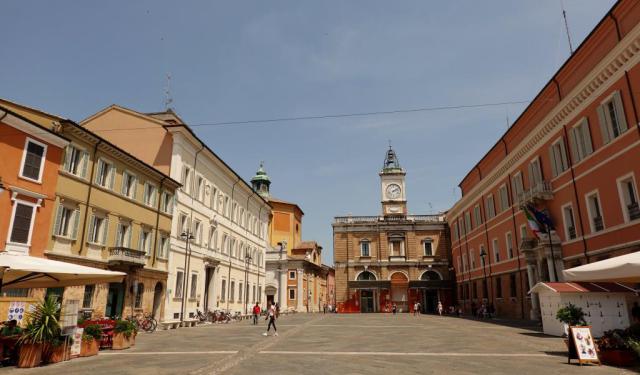Basilica of Sant'Apollinare Nuovo (Basilica of Saint Apollinaris the New), Ravenna (must see)
The Basilica of Saint Apollinaris the New in Ravenna, Italy, holds a rich history. Initially constructed as a palace chapel by the Ostrogothic king Theodoric the Great in the early 6th century, it was dedicated to "Christ the Redeemer" in 504 AD.
In 561 AD, under Byzantine Emperor Justinian I, the church was rededicated as "Sanctus Martinus in Coelo Aureo" ("Saint Martin in Golden Heaven") after suppressing Arianism. It was named in honor of Saint Martin of Tours, a staunch opponent of Arianism.
Legend has it that Pope Gregory the Great ordered the blackening of the church's mosaics because their golden splendor distracted worshippers from their prayers.
The basilica received its present name in 856 AD when relics of Saint Apollinaris were transferred from the Basilica of Sant'Apollinare in Classe due to frequent pirate raids from the Adriatic Sea.
A 16th-century marble portico stands at the church's entrance, and a round bell tower from the 9th or 10th century is located on the right side of the portico.
Over the centuries, the apse and atrium underwent renovations, with some original mosaics being destroyed. Nevertheless, mosaics on the lateral walls, twenty-four columns with simplified Corinthian capitals, and an Ambo have been preserved.
The mosaics were modified in the mid-19th century by Felice Kibel, and the apse was reconstructed after sustaining damage during World War I.
The church's walls feature mosaics depicting Jesus' miracles, parables, saints, prophets, and evangelists. The figures in these mosaics are noted for their individual expressions, following a Hellenistic-Roman tradition.
Some art historians suggest that one of the mosaics contains the first depiction of Satan in Western art. In this mosaic, a blue angel appears on Jesus' left, behind three goats, as mentioned in Saint Matthew's account of Judgement Day.
In 561 AD, under Byzantine Emperor Justinian I, the church was rededicated as "Sanctus Martinus in Coelo Aureo" ("Saint Martin in Golden Heaven") after suppressing Arianism. It was named in honor of Saint Martin of Tours, a staunch opponent of Arianism.
Legend has it that Pope Gregory the Great ordered the blackening of the church's mosaics because their golden splendor distracted worshippers from their prayers.
The basilica received its present name in 856 AD when relics of Saint Apollinaris were transferred from the Basilica of Sant'Apollinare in Classe due to frequent pirate raids from the Adriatic Sea.
A 16th-century marble portico stands at the church's entrance, and a round bell tower from the 9th or 10th century is located on the right side of the portico.
Over the centuries, the apse and atrium underwent renovations, with some original mosaics being destroyed. Nevertheless, mosaics on the lateral walls, twenty-four columns with simplified Corinthian capitals, and an Ambo have been preserved.
The mosaics were modified in the mid-19th century by Felice Kibel, and the apse was reconstructed after sustaining damage during World War I.
The church's walls feature mosaics depicting Jesus' miracles, parables, saints, prophets, and evangelists. The figures in these mosaics are noted for their individual expressions, following a Hellenistic-Roman tradition.
Some art historians suggest that one of the mosaics contains the first depiction of Satan in Western art. In this mosaic, a blue angel appears on Jesus' left, behind three goats, as mentioned in Saint Matthew's account of Judgement Day.
Want to visit this sight? Check out these Self-Guided Walking Tours in Ravenna. Alternatively, you can download the mobile app "GPSmyCity: Walks in 1K+ Cities" from Apple App Store or Google Play Store. The app turns your mobile device to a personal tour guide and it works offline, so no data plan is needed when traveling abroad.
Basilica of Sant'Apollinare Nuovo (Basilica of Saint Apollinaris the New) on Map
Sight Name: Basilica of Sant'Apollinare Nuovo (Basilica of Saint Apollinaris the New)
Sight Location: Ravenna, Italy (See walking tours in Ravenna)
Sight Type: Religious
Guide(s) Containing This Sight:
Sight Location: Ravenna, Italy (See walking tours in Ravenna)
Sight Type: Religious
Guide(s) Containing This Sight:
Walking Tours in Ravenna, Italy
Create Your Own Walk in Ravenna
Creating your own self-guided walk in Ravenna is easy and fun. Choose the city attractions that you want to see and a walk route map will be created just for you. You can even set your hotel as the start point of the walk.
Ravenna Introduction Walking Tour
Ravenna may not appear on everyone’s Italy wish list like Venice or Rome, but it’s worth visiting during your Italian holiday. Often referred to as the "capital of mosaics", the city is known for its well-preserved late Roman and Byzantine architecture comprising the UNESCO World Heritage Site ("Early Christian Monuments of Ravenna").
Initially settled by the Umbri... view more
Tour Duration: 2 Hour(s)
Travel Distance: 2.5 Km or 1.6 Miles
Initially settled by the Umbri... view more
Tour Duration: 2 Hour(s)
Travel Distance: 2.5 Km or 1.6 Miles
Byzantine Mosaics Walking Tour
What are precious jewels, you may ask. Well, let me tell you – Ravenna’s Byzantine mosaics are surely among the most sparkling, spectacular, and valuable. So much so that they were recognized as World Heritage by UNESCO in 1996.
Indeed, Ravenna is like no other place in Italy, and the magnificence of its mosaics can leave you with a stiff neck. The intricate mosaic work achieved some of... view more
Tour Duration: 1 Hour(s)
Travel Distance: 2.0 Km or 1.2 Miles
Indeed, Ravenna is like no other place in Italy, and the magnificence of its mosaics can leave you with a stiff neck. The intricate mosaic work achieved some of... view more
Tour Duration: 1 Hour(s)
Travel Distance: 2.0 Km or 1.2 Miles





